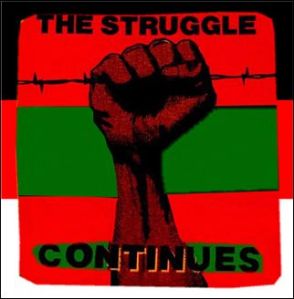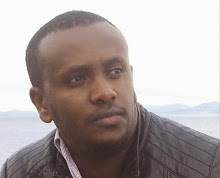By Seid Hassan and Minga Negash | March 28, 2014
In our December 19, 2013 article entitled “Explaining the Ethiopian outmigration: incentives or constrains” we alerted readers and policy makers in Ethiopia about the push, pull and mediating factors of outmigration in general and outlined the factors as they relate to Ethiopia. In this short article we aim to discuss further the incompatibility between macroeconomic growth and outmigration and close the piece by outlining potential mitigation strategies.
By the end of 2013 and early 2014 the world witnessed yet another shame of Ethiopians. Voices of men, women and children in Saudi Arabia, Lebanon, Libya, Southern Europe and Southern Africa are instantly being transmitted across the globe through the use of advanced information technology. Saudi Arabia alone deported at least 165,000 Ethiopians within the span of few weeks. Demonstrations were held in Kuwait and Israel against African immigrants. The European Union has erected various forms of fences against immigrants from Africa. As
Emnet Assefa of Addis Standard, a journalist in one of the local newspaper noted, “[o]ver the last few years, news of young Ethiopian men and women found dead inside jam-packed containers loaded on heavy duty trucks has become a routine media exercise both locally and in many parts of the continent.” Abuses, abductions, disappearances and killings of Ethiopians in the
Middle East,
North Africa, and
Gulf States has become common. On Thursday March 20, 2014 the (U.S. based) National Public Radio (NPR) run a heart-wrenching story of an Ethiopian young woman who took unbelievable levels of risks and investments to reach the shores of the United States. While outmigration is the history of mankind, as indicated in the holy books, for example, modern day migration, particularly migration into the Middle East, is documented to be associated with
calamities.
Detentions of Ethiopians for violating the immigration laws of other countries (such as in
Kenya,
Tanzania,
Uganda,
Zambia,
Zimbabwe), deportations,
refugee camps filled with Ethiopians, and sending the remains of Ethiopians who died in their search for better lives and liberty has become routine. Disturbed by the depressing news and the total failure of the Government of Ethiopia (GOE), the Ethiopian diaspora held noisy protest demonstrations in front of the Saudi Arabian and Ethiopian embassies, collected petitions, contributed and
donated some funds to the International Organization for Migration (IOM) to aid returnees and painfully listened to the information provided by foreign based radios and websites. While these are normal reactions and laudable works, they are nonetheless temporary measures and will not serve as mitigation strategies unless one understands the causes, scale and depth of the problem, and consider a range of possible policy options.
The Horn of Africa has been and continues to be one of the hot spots of major human movements in the world. Civil wars, secessionist conflicts, tribal-clan warfare, famine, land scarcity and evictions, and poverty have been the causes of both internal displacements and cross border migration. At the time of writing this article, tens of thousands of Sudanese refugees are reportedly crossing the border and entering the Ethiopian territory in search of security. The civil wars in North and South Sudan, tensions and skirmishes in the Eritrean-Ethiopian borders, sectarian and secessionist movements in Somalia and the Ogaden, ethnic, religious and clan tensions, land grabs and repression have been some of the culprits of the migration.
In addition to the instability and government failures in the region, it is important to note that globalization often manifests itself in the form of increased movement of capital, freer movement of goods and services, internationalization of production and investments, and information about labor demand. Hence, outmigration must also be examined in the context of the global trends in the import and export of labor. Immigration magnet countries generally have labor shortages as in the Middle Eastern countries while exporting countries benefit from remittances. In other words, one might be tempted to ask whether the remittance that a country receives from the export of both skilled and unskilled labor drives a government’s policy towards emigration. This question is pertinent to Ethiopia as the country exports both skilled and unskilled labor and its annual earnings from remittances is estimated at about 3 billion dollars, a figure that is more than the revenue it obtains from exporting products. In addition, the government has been trying to finance mega projects through the issuance of low interest and high risk diaspora bonds.
However, consistent with theory, Ethiopians spend their remittance earnings on consumer goods and alleviating family hardships. Remittance expenditures on consumption goods, particularly imports, therefore, is believed to have played their own roles in exacerbating the high cost of living in the country and widening its trade deficit, in addition to raising the birr’s real exchange rate and escalating real estate prices. Anecdotal evidence also shows that a good number of Ethiopian diaspora members are deeply involved in the real estate sector, particularly housing. Using its monopoly power on land, the government has been engaged in evicting entire neighborhoods, including the forced removal of the remains of the dead from grounds that traditionally belonged to the churches, and building roads and
auctioning the confiscated lands at artificially inflated prices that are often set through insider trading of information. This is in addition to continuously raising rental prices. The use of remittances in real estate thus could only add fuel to the fire, thereby making housing unaffordable to residents. Anecdotal evidence also shows that remittances have played their own roles in fueling corruption and heightening rural and urban land speculation.
Notwithstanding the above, the GoE has been claiming that the country has been enjoying double-digit real economic growth for about one decade. The growth statistics however has been questioned by several economists and as of late even magazines that used to be known for echoing the government’s line of story have started to question the validity of the government provided statistic. Secondly, the country is known to have achieved “stability” since 2000, while at the same time neighboring countries such as Sudan and Somalia found themselves embroiled in escalated internal conflicts and with their neighbors. These stories spark a number of important questions. First, given that the country is claimed to be at “peace” with itself and is also a peace-maker in the Horn of Africa (such as contributing troops in Somalia, Sudan and beyond), and with a “federal multi-party system” in place, why would one observe documents and criticisms against the government? Why should the residents of a land with a growing economy and “federal democracy” choose to emigrate en mass In other words, could outmigration and economic growth move in the same direction or move in different directions or have no association between themselves at all? To answer these questions in the context of Ethiopia, one needs to review the relevant literature.
*Source: de Haas (2010) Migration transitions: a theoretical and empirical inquiry into the developmental drivers of international migration’. IMI Working Papers. Oxford, University of Oxford
A quick review of the relevant literature suggests that as development level increases immigration increases as the country becomes a magnet for foreigners and its own diaspora population. However the association between emigration and economic development is negative. Figure 1 shows the migration transition theory of de Haas (2010), which is now popular among researchers on migration. Validating the migration transition theory in the context of Ethiopia requires an empirical research. Unfortunately, empirical research on economic, social and demographic data is generally hard in developing countries because of data reliability and more importantly the politicization of such information. To test the validity of de Haas’s (2010) model, we reviewed the academic and policy literature, applied qualitative-phenomenological methods of research and outlined policy options.
In its November 2012 report, the International Migration Institute at Oxford University confirmed the common knowledge of Ethiopians, and documented that between 1960 and 2000 Ethiopia’s outmigration was one of the lowest in the Horn of Africa. Authorized emigrant population (including asylum seekers) in 2000 was less than 300,000 – lower than Eritrea, Kenya, Somalia, Sudan, Uganda and Yemen. As a percentage of the size of the population, Ethiopia’s outmigration was also the lowest. However, this statistics requires further analysis as the impacts of conflicts in Eritrea, Tigrai, Ogaden and Somalia, famine, conscriptions for the various wars and the red terror were responsible for driving thousands of refugees to the Sudan, Somalia, Djibouti and Kenya.
Fransen and Kuschminder (2009:17) of Maastricht University , citing the World Bank, confirmed the findings of the International Migration Institute and stated that “migration flows out of Ethiopia are relatively small”. The World Bank estimated an emigration rate of 0.6 percent of the population in 2005, which amounts to a stock of 445,926 persons”. And in-migration (refugees from neighboring countries) and outmigration of Ethiopians to neighboring countries as refugees, according to the UNHCR, balanced one another, suggesting that the net migration during the period was close to zero. However, like the Institute of Migration’s data, Fransen and Kuschmider’s work heavily relied on limited literature review and extrapolated statistics using data from IOM, UNHCR, OECD and the World Bank. Their results therefore, may not be useful to predict or understand the scale and form of the migration current crisis. Furthermore, an important factor in analyzing international data is that most of the reports contain only the number of refugees that have been recognized. For instance the World Bank’s recent report does not include registered asylum seekers or the number undocumented Ethiopians living out of their country. The bank reported that between 2009 and 2011 the number of Ethiopian refugees who have been granted refugee status were respectively 121,886; 154,295 and 288,844, showing an annual growth rate of 26.59% and 87.2%. In sum, obtaining reliable data and information about the Ethiopian outmigration is a major issue. Unfortunately, the unreliability of the Ministry of Foreign Affairs Diaspora Department figures compound the problem.
Notwithstanding the above difficulties, in our December 19, 2013 article, we attributed the Ethiopian outmigration mainly to push factors and following the norm in the migration literature, we outlined the factors under four major categories. We have reproduced them here for the benefits of our readers. The four categories are (1) Supply-Push (Predisposing or Repulsive) Factors- which drive/force migrants out of their country of origin. Examples include poverty, the lack of economic opportunities and jobs, economic downturns, political oppressions, abuses of human rights, religious intolerance (constraints), wars, conflicts and insecurities in the home country; (2) Demand-Pull-factors- which in general are positive and are responsible in attracting migrants. Examples include: higher wage rates and better standard of living in destination countries; higher and steady demand for cheap and unskilled labor in destination countries’ informal economies (domestic work, construction, services such as cleaning, restaurant and fast food services), political and religious freedom in destination countries; (3) Mediating Factors, which are divided into two conflicting factors: (a) Facilitating/encouraging factors- which are the ones that trigger, enable and accelerate departure. Examples include the availability of visas, passports, transport, communications, information, recruiters, brokers, traffickers and smugglers, porous borders, and the resources needed for the journey, distance to and between sending and destination countries and length of transit periods. (b) Restraining/constraining factors or intervening obstacles- are the ones which work against making the journey – such as the lack of the ones described in (a) above, high migration costs, perceived risks, stricter controls of recruitments, stiff punishments and penalties against smugglers and traffickers, rogue employment practices in destination countries; and (4) Social network (pull) factors – such as the existence of relatives, friends and acquaintances in host/destination countries, available opportunities for family unifications in host countries, or when individuals send money to bring other family members to join them into the new (host) country- a chain migration which results in migration fields or clustering of people from specific countries into certain neighborhoods or small towns in the new (host) countries (e.g. China Town, Vietnamese Town, Little Ethiopia, etc. in North America). Mediating factors also include success stories of the diaspora.
Returning to the issue about the link between economic growth and migration, in the case of Ethiopia, unlike the growing domestic product data reported by the government and the high rise buildings and construction projects that are undergoing in recent years, the human development indicators generally show that there has been little progress in alleviating poverty in the country (According to UNDP’s 2011 survey, Ethiopia is in the low human development category—positioning the country at 173 out of 187 with 87.3 percent of the country’s population lived in multidimensional poverty (MPI)). Despite the big push and donor support, early human development indicators reveal that Ethiopia, unfortunately, will not be able to meet many of the MDG goals by 2015. Thus, the GoE must blame itself for washing away the donor propelled gain in the economy by inflation. Perhaps, a better indicator could be creating a misery level tracking index, which can be computed by the sum of the country’s inflation rate, unemployment rate, augmented by annual changes in outmigration and subtracting the country’s economic growth rate. In this respect, in a recent paper, Abebe Shimeles and Andenet Delelegn (see African Development Bank Group Working paper No 182 September 2013), using household data that was collected by Addis Ababa University in collaboration with Oxford University and the University of Gothenburg attempted to empirically examine the welfare effects of rising food prices (inflation). They show that between 2000 and 2006, the Ethiopian economy has had a cumulative welfare loss of 53%. The “true” level of welfare loss was 12% worse than what was estimated by the GoE’s statisticians. Between 2007 and 2013 Ethiopia has seen a series of sharp increases in the cost of living, reaching as high as 64% in 2008. The country also “officially devalued the Birr by over 102% against the U.S. Dollar between November 2007 and February 2013 despite being warned that devaluation would not have its intended effects without addressing the country’s economic fundamentals.
While the increases are not unparalleled by the history of hyperinflation, the growth claim made by the GoE appears unparalleled indeed. The ramifications of these inaccuracies for economic planning and hardship (misery index) and outmigration, in an environment of the feminization of poverty are serious. Inflation also has wealth transfer effects and widening inequality especially when it occurs under an environment of full control of land by the government, credit channeling, excessive money supply and monetization of government borrowing, and political-party owned and state owned enterprises. Indeed, there are numerous signs indicating that the government’s Growth and Transformation Plan (GTP) “belies the reality on the ground”, is a “misguided economic policy”, and too “fanciful” to trust. As one of the pro-government local papers noted, the GTP was just one of a “number of fashionable ideas and initiatives” … concocted by the late Prime Minister Zenawi and his party elites…” – the concocted ideas being just a “theoretical synthesis” rather than being practically applicable to the Ethiopian context. As predicted by Ken Ohashi, the then World Bank Country Director for Ethiopia, the GTP has become unsustainable, all signs indicating its failure. The tell-tale signs are indicated by: the government’s neglect of the manufacturing sector of the economy (Economist, March 02, 2013, Enku Magazine’s interview of Mr. Mushe Semu, May, 2013 edition, Reporter, October 5, 2013, Addis Fortune, March 9, 2014); the gloomier picture of the flower industry (Reporter, February 8, 2014); the sharp declines in the country’s exports (Reporter: October 5, 2013, January 11, 2014, Addis Fortune), the deterioration of the country’s indebtedness (Ezana Kebede, 2014); the credit crunch facing the private sector (Reporter, February 8, 2014); the negative ramifications in foreign exchange shortages (
Wall Street Journal, January 6, 2014); the deprived private sector: (IMF); the rising tide of corruption (World Bank, Global Financial Integrity, Hassan) and disturbingly, the falsely trumpeted “gains” in the agricultural sector, where most of the out-migrants originate (AllAfrica.com, January 19, 2014).
Now that we have shown outmigration is incompatible with a growing economy, the GoE and the donor community need to take the bull by the horn and address key issues that hold the economy from growing and also the drivers of emigration. The ruling party cannot escape re-examining its land policy and restructure the ownership structure in the economy, liberate the markets so that private enterprise would flourish; it should allow the archaic finance industry to respond to the realities of the economy; seriously fight inflation and corruption, grant the poor the freedom to vote on policy, and put in place sound controls against illicit financial flows and human smuggling; design and implement sound population development and family planning policy; restructure public and private information dissemination institutions to allow robust debate on national policy. The government needs to guarantee and respect private property and put in place reliable investor protection mechanisms. More importantly, it needs to take concrete conflict prevention strategies and open the political space at home in order to reduce political instability and minimize the probability of yet another round of large scale outmigration. The available data and the realities on the ground strongly show that both inter-migration and intra-migration have become serious issues for the country. The GoE therefore needs to consider establishing a research center for migration studies in one of the universities.
Outmigration also requires reforming the Ministry of Foreign Affairs and the Ministry of Labor. Like other nations, Ethiopia, on behalf of its citizens, needs to promote cooperation and negotiate minimum labor standards in host countries. It must push migrant recipient countries the International Convention on the Rights of Migrant Workers and their Families (ICRMW), one of the core international human rights treaties. For emigrants who go to specific destinations, the government can create incentives for minimum level of skills certifications. It needs to provide coping mechanisms and establish a desk in the embassies for handling physical, emotional and sexual abuses and cultural prejudices faced by immigrants, in general, and women in particular. The remittance obtained from destination countries could justify the additional costs of providing the above services. The country must be able to pass and implement effective regulation against “agents” and human smugglers. The government also needs to re-examine the de facto policy of using remittances (i.e. exporting people) as developmental instrument, for the macroeconomic effects are ambiguous at best.
The Ethiopian diaspora community must also do its part. Most of the diaspora institutions are divided, weak and poorly managed. Similar to the politics inside the country, the diaspora is divided along political, ethnic and regional lines. Hence, there is no “national consensus” and the government’s diaspora policy has become part of the problem. The GoE leaders often face booing and protest demonstrations when they travel abroad. They in turn label their critics as “extremists”, “chauvinists” and even “terrorists”. The diaspora is predominantly unengaged and a small proportion appears to be opportunistic. The majority fears reprisal from the government for showing dissent or for not cooperating with the embassies. With regard to the economic impact, other than the remittance, the magnitude of diaspora’s “contribution” to development appears to be a moot point. Furthermore, unlike out-migrants of other countries, Ethiopian out-migrants seem to have failed to pay attention to the ongoing politics of their respective destination countries. The use of immigrants as political punch bags by the Saudi authorities could have been minimized if Ethiopian migrants were paying attention to the upcoming of large scale and politically-motivated deportations. Finally, Ethiopian immigrants must take lessons from the recent deportations and establish strong centers in their respective destination countries and create a global network that supports the community in times of crisis
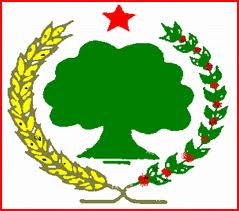




 March 28, 2014 (Borkena) –The Resilient Ethiopian Muslim Movement is back. Today, Ethiopian Muslims were demonstrating again in the capital Addis Ababa and different parts of Ethiopia. The Grand Anwar Mosque in Addis Ababa was once again a place to oppose government peacefully after procession of Friday prayer.
March 28, 2014 (Borkena) –The Resilient Ethiopian Muslim Movement is back. Today, Ethiopian Muslims were demonstrating again in the capital Addis Ababa and different parts of Ethiopia. The Grand Anwar Mosque in Addis Ababa was once again a place to oppose government peacefully after procession of Friday prayer. ello Everyone,
ello Everyone,

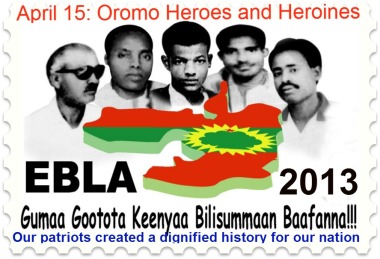 First, this day allows us to remember those Oromo heroines and heroes who sacrificed their lives to restore Oromo culture, identity, and human dignity that were wounded by Ethiopian colonialism. In other words, this commemoration assists us to recognize the dialectical connection between martyrdom, bravery, patriotism and Oromummaa.
First, this day allows us to remember those Oromo heroines and heroes who sacrificed their lives to restore Oromo culture, identity, and human dignity that were wounded by Ethiopian colonialism. In other words, this commemoration assists us to recognize the dialectical connection between martyrdom, bravery, patriotism and Oromummaa.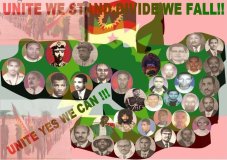 Our martyrs lost their lives while dreaming and fighting for freedom, justice, democracy, and development of their people and their country. They recognized that agitating, educating, organizing, and mobilizing a colonized and dehumanized nation for liberation requires courage, determination, bravery and self-sacrifice without fear of suffering and death in the hands of the enemy and their collaborators. We have moral and national responsibilities to achieve the objectives for which our heroines and heroes sacrificed their lives.
Our martyrs lost their lives while dreaming and fighting for freedom, justice, democracy, and development of their people and their country. They recognized that agitating, educating, organizing, and mobilizing a colonized and dehumanized nation for liberation requires courage, determination, bravery and self-sacrifice without fear of suffering and death in the hands of the enemy and their collaborators. We have moral and national responsibilities to achieve the objectives for which our heroines and heroes sacrificed their lives. HRLHA Urgent Action
HRLHA Urgent Action
